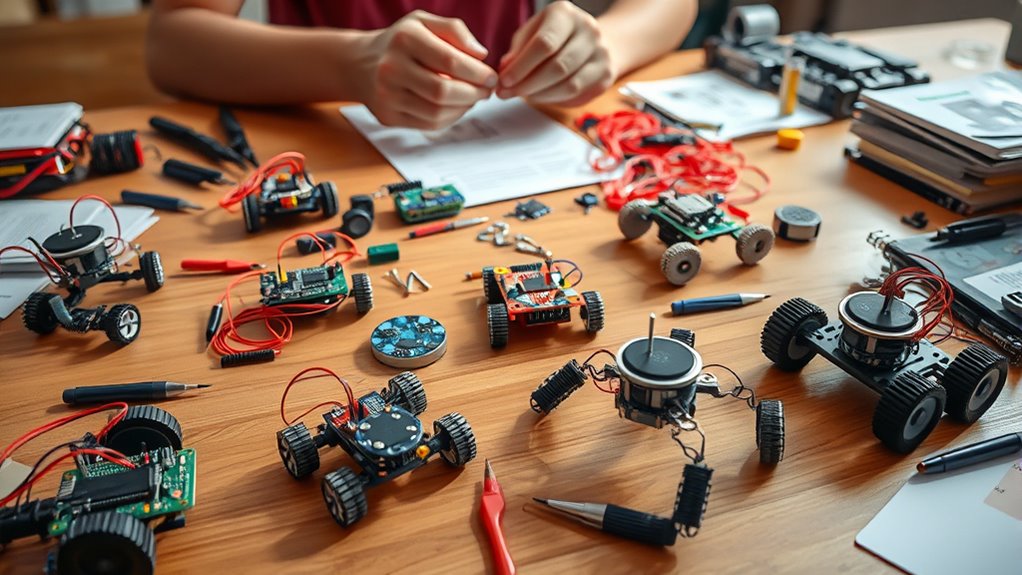If you’re looking to spark your creativity with DIY robot kits, I recommend exploring options like the Butterfly Edufields 10-in-1 STEM set, versatile robot toys with app control, and advanced kits such as ESP8266 Spider Robot or Raspberry Pi-based car kits. There’s a range of beginner-friendly and more complex options, each promoting skills like engineering, coding, and problem-solving. Keep exploring, and you’ll discover the perfect project to challenge and inspire you.
Key Takeaways
- A variety of kits cater to different skill levels, from beginner-friendly Arduino and solar robots to advanced programming sets.
- Many kits promote STEM learning, problem-solving, creativity, and hands-on building experiences for all ages.
- Features include durable materials, detailed instructions, and components like motors, sensors, and programmable boards.
- Assembly challenges such as small parts, fit issues, and unclear directions help develop patience and troubleshooting skills.
- Environmental factors like sunlight and battery options influence robot performance and user engagement.
Butterfly Edufields 10-in-1 STEM Robotics Kit for Kids
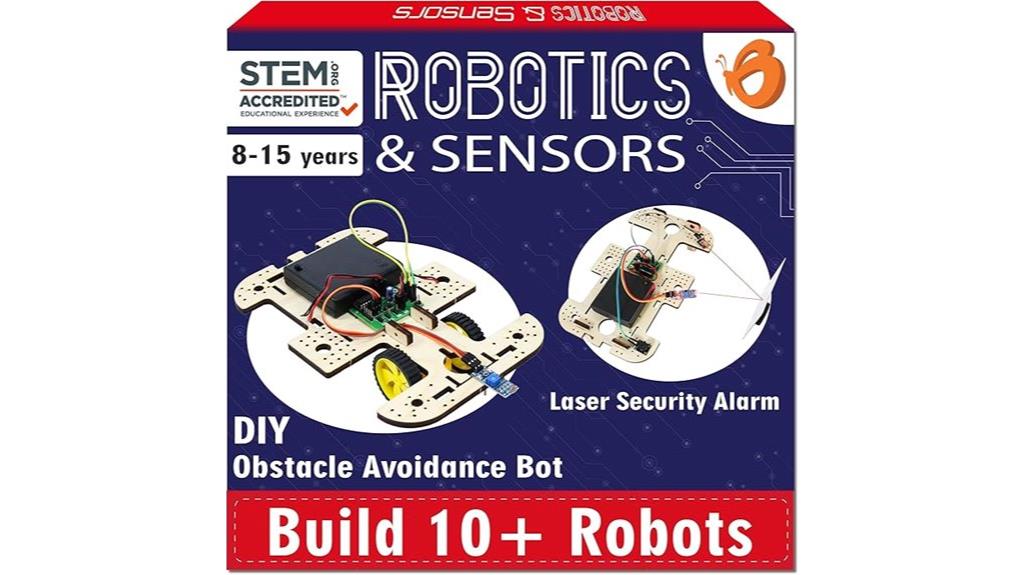
If you’re looking for an engaging STEM toy for kids aged 8 to 14, the Butterfly Edufields 10-in-1 STEM Robotics Kit is a great choice. It offers hands-on learning in robotics, electronics, and mechanics with over 100 components like wires, LEDs, and switches. Kids can easily build multiple models within 15 minutes thanks to simple, step-by-step instructions. The kit promotes critical thinking, creativity, and problem-solving while making complex concepts accessible. Perfect as a birthday or holiday gift, it inspires young engineers and scientists to explore STEM fields through fun, practical projects. Despite some quality concerns, it remains a popular educational tool.
Best For: kids aged 8 to 14 who are interested in hands-on STEM learning, robotics, and creative engineering projects.
Pros:
- Promotes critical thinking, creativity, and problem-solving skills through engaging DIY projects.
- Includes over 100 components for versatile building options and practical experimentation.
- Easy-to-follow step-by-step instructions facilitate quick assembly, making it suitable for beginners.
Cons:
- Some users report quality issues such as fragile parts, mismatched components, and faulty LEDs.
- Small screws and delicate pieces can be challenging for children to handle and may require additional tools.
- Inconsistent component quality and assembly difficulties can lead to frustration and project failures.
Robot Toys for 8-16 Year Old Kids with App or Remote Control
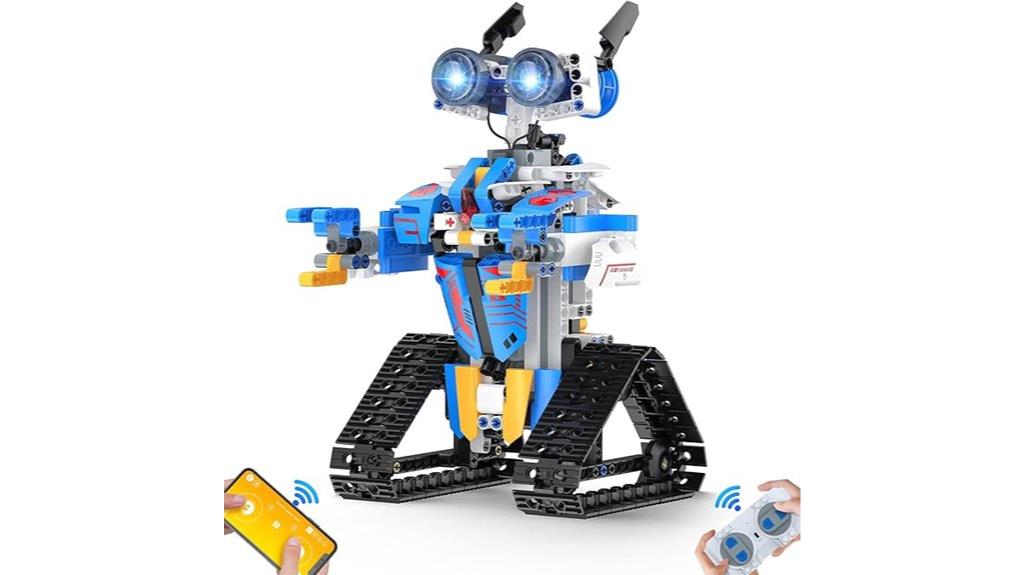
Looking for a robot toy that combines hands-on building with versatile control options? This robot kit offers over 468 pieces, stickers, and accessories, making construction engaging and educational for kids aged 8-16. It moves in all directions—forward, backward, left, right, and 360° rotation—and features glowing eyes and transforming capabilities. Controlled via app, remote, voice, or gravity sensor, it has a range over 20 meters. The kit includes step-by-step manuals, durable non-toxic materials, and safety features. It’s perfect for developing STEM skills, motor coordination, and creativity, all while providing hours of fun and hands-on learning.
Best For: kids aged 8-16 who enjoy hands-on building, STEM learning, and versatile remote or app-controlled robot play.
Pros:
- Offers over 468 building pieces and accessories that promote creativity and educational development
- Features multiple control modes including app, remote, voice, and gravity sensor with a range over 20 meters
- Made of durable, non-toxic materials with safety features and step-by-step assembly manuals
Cons:
- Some users experience issues with loose parts, LED connections, or app responsiveness
- Limited programmability and voice control functions, with some features not fully supported or in Chinese
- Assembly can be challenging due to parts not clicking tightly or instructions being slightly confusing
STEM Robotics Science Kit with ESP8266 Spider Robot and Remote Control
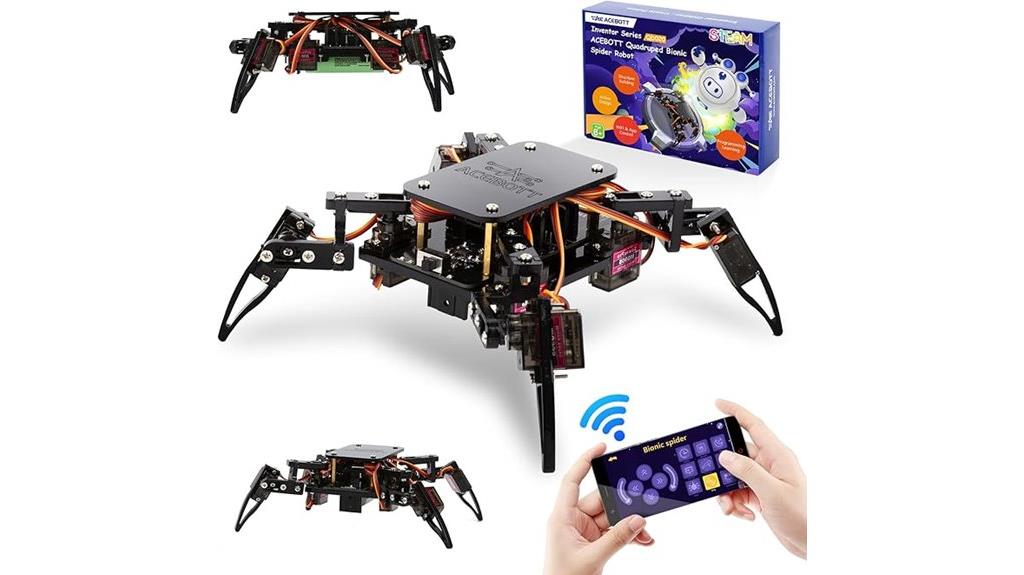
The STEM Robotics Science Kit with ESP8266 Spider Robot and Remote Control is an excellent choice for tech-savvy teens and adults enthusiastic to plunge into robotics and programming. This kit offers hands-on learning with easy assembly, featuring a durable acrylic body, metal servo, and multiple movement modes controlled via an app. It includes detailed tutorials, step-by-step guides, and coding resources to promote STEM education. While assembly can be fiddly and software setup tricky, it rewards users with smooth motion and programmable actions. Keep in mind, you’ll need to purchase a compatible battery separately. Overall, it’s a fun, educational project that sparks creativity and engineering skills.
Best For: tech-savvy teens and adults interested in hands-on robotics, programming, and STEM education.
Pros:
- Promotes engaging, practical learning in electronics, coding, and engineering principles
- Durable acrylic body and metal servo ensure stable and smooth robot movements
- Comprehensive tutorials, guides, and online resources facilitate assembly and programming
Cons:
- Assembly can be fiddly and may require patience and small tools
- Software setup and hardware integration can be complex and challenging for beginners
- Requires purchasing a compatible rechargeable battery separately, with some users experiencing fitting issues
SunFounder PiCar-X AI Robot Car Kit for Raspberry Pi (RPI Not Included)
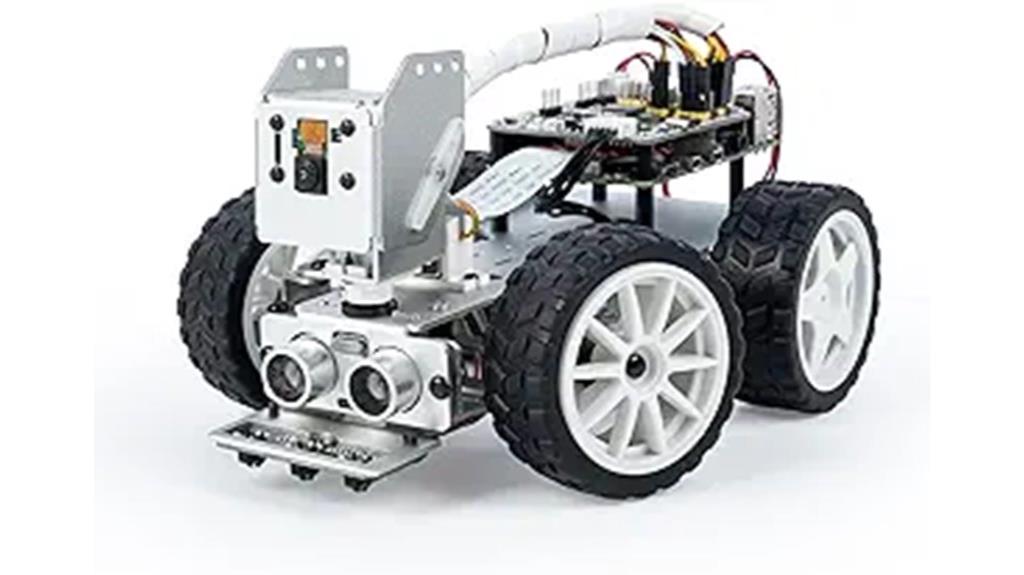
The SunFounder PiCar-X AI Robot Car Kit stands out as an excellent choice for beginners and young learners interested in exploring robotics, programming, and AI. Designed for Raspberry Pi 5/4/3B+/3B/Zero W (Raspberry Pi not included), it offers engaging features like video recognition, voice interaction, and gesture control, enhanced with ChatGPT-4o integration. The kit includes a camera, sensors, and modules for line following and obstacle avoidance, supporting both Python and Scratch programming. Its high-quality hardware, detailed instructions, and expandability make it ideal for education and experimentation. While assembly can be straightforward, some computer knowledge helps, and support resources are readily available.
Best For: beginners, young learners, and educators interested in exploring robotics, programming, and AI with an accessible and expandable robot kit.
Pros:
- High-quality hardware with detailed instructions and support resources.
- Supports multiple programming languages like Python and Scratch, ideal for learning and experimentation.
- Features advanced AI capabilities including video recognition, voice interaction, and gesture control.
Cons:
- Assembly may be challenging for some users, especially without prior computer knowledge.
- Use of rivets instead of screws can limit adjustability and customization.
- Connectivity issues with Bluetooth and Wi-Fi reported by some users, particularly on Windows and Android devices.
ELEGOO UNO R3 Robot Car Kit for Arduino STEM Coding for Kids and Teens

If you’re introducing kids or teens to robotics and coding, the ELEGOO UNO R3 Robot Car Kit V4 is an excellent choice because it combines easy assembly with extensive educational content. Designed for beginners aged 8-16, it offers hands-on experience with assembling, coding, and understanding robotics concepts. The kit includes 24 modules like obstacle avoidance, line tracing, infrared remote control, and WiFi control via Android and iOS devices. With detailed instructions, pre-loaded code, and no soldering required, it’s accessible and rewarding. The sturdy parts, versatile sensors, and compatibility with Arduino IDE make it perfect for learning, experimenting, and growing into more complex projects.
Best For: beginners aged 8-16 interested in learning robotics, electronics, and programming through hands-on assembly and coding experiences.
Pros:
- Easy to assemble with clear instructions and pre-loaded code, ideal for beginners.
- Includes a variety of modules like obstacle avoidance and WiFi control for versatile learning.
- Durable parts and compatibility with Arduino IDE support customization and future projects.
Cons:
- Software setup can be complex, requiring troubleshooting for library errors and compatibility issues.
- Assembly may be challenging for very young children due to small parts and detailed instructions.
- Limited I/O pins on the UNO may restrict adding multiple external devices without extra controllers.
Sillbird STEM 12-in-1 Solar Robot Kit for Kids
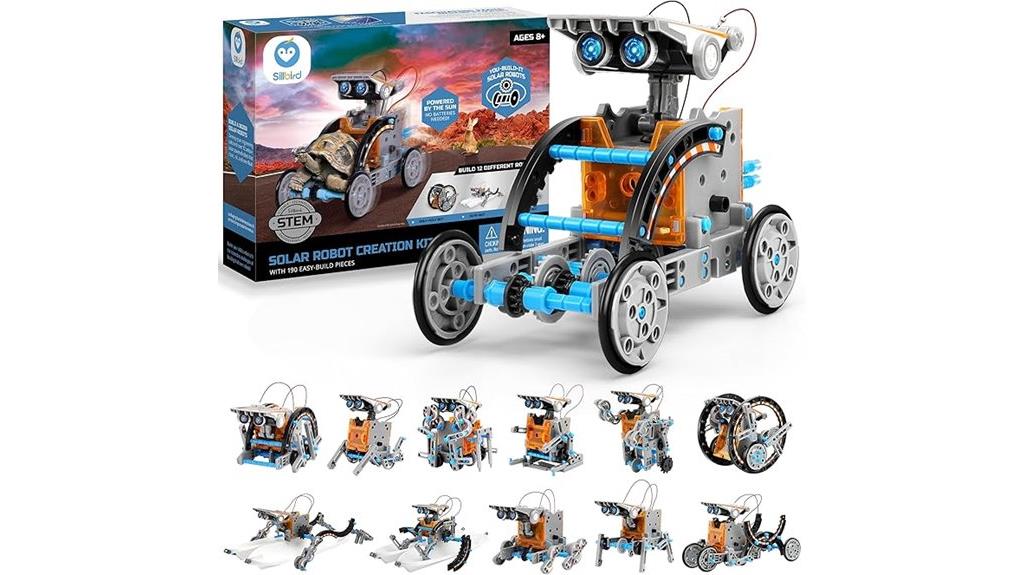
Designed for kids aged 8 to 13 who love hands-on science projects, the Sillbird STEM 12-in-1 Solar Robot Kit offers an engaging way to explore renewable energy and engineering concepts. It includes 12 different robots that can move on land or water, with varying complexity levels from beginner to advanced. Powered by an upgraded larger solar panel, it provides stronger energy and promotes green technology learning. Although assembly can be challenging due to small parts and fit issues, the kit encourages problem-solving, teamwork, and STEM skills. It’s a fun, educational toy that sparks curiosity about robotics and renewable energy while fostering confidence in young learners.
Best For: kids aged 8 to 13 who enjoy hands-on STEM projects, robotics, and exploring renewable energy concepts.
Pros:
- Encourages STEM learning, problem-solving, and teamwork through engaging building activities.
- Features a larger solar panel for improved power and environmentally friendly operation.
- Offers a variety of 12 robots with different complexity levels, suitable for different skill stages.
Cons:
- Assembly can be challenging due to small parts, fit issues, and unclear instructions.
- Some parts may break or require trimming, affecting durability and performance.
- Performance depends heavily on strong sunlight or halogen lamps, which may limit usability indoors or in low light.
STEM Robotics Science Kits for Kids Aged 6-12
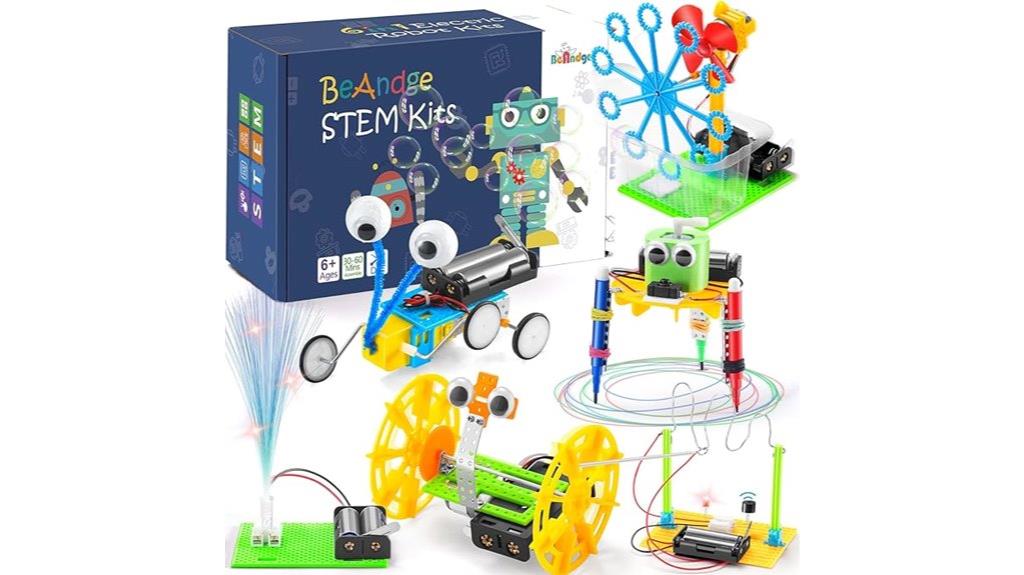
Are you looking for an engaging way to introduce kids aged 6-12 to STEM principles? These STEM Robotics Science Kits are perfect for sparking curiosity. They include six projects, like a reptile robot, balance car, and bubble machine, made from safe, odorless materials. The kits come with detailed instructions and mini screwdrivers, making assembly straightforward, though batteries and bubble solution are extra. Designed for ages 6-14, they promote hands-on learning, problem-solving, and creativity. Plus, they’re great for family bonding and educational gifts. With positive reviews and a variety of projects, these kits make science fun and accessible for young enthusiasts.
Best For: parents, educators, and young science enthusiasts aged 6-12 seeking engaging, educational STEM activities that promote hands-on learning and family bonding.
Pros:
- Offers a variety of six different projects to keep children engaged and stimulated.
- Made from safe, odorless materials suitable for young children with detailed instructions for easy assembly.
- Encourages development of critical thinking, engineering, and problem-solving skills in a fun, interactive way.
Cons:
- Small screws and parts may be challenging for younger children or those with limited dexterity, requiring adult assistance.
- Batteries and bubble solution are not included, necessitating additional purchases.
- Some users reported missing components or difficulty with certain projects, which can be disappointing or require extra support.
STEM 13-in-1 Solar Power Robots Educational Kit for Kids
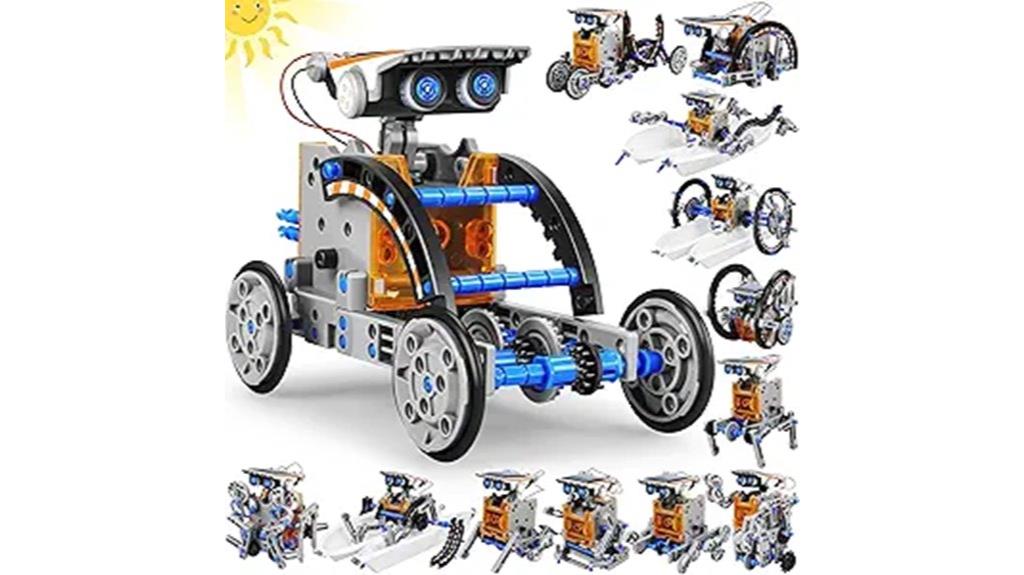
The STEM 13-in-1 Solar Power Robots Educational Kit is perfect for kids aged 8 to 12 who are curious about science and engineering. I love how it offers hands-on fun by allowing children to build 13 different models, from animals to vehicles, all powered by solar energy—no batteries needed. The kit promotes learning about renewable energy and sustainability while developing problem-solving and engineering skills. The components are made from safe, non-toxic materials, and detailed instructions help kids assemble models independently or with help. Despite some challenges with fragile parts and solar efficiency, it’s a great way to inspire curiosity and creativity in young learners.
Best For: kids aged 8 to 12 who are interested in exploring STEM, renewable energy, and hands-on robotics projects.
Pros:
- Promotes STEM learning through engaging, interactive building activities
- Encourages environmental awareness by using solar power without batteries
- Comes with detailed instructions suitable for independent or guided assembly
Cons:
- Some parts may be fragile or difficult to fit, requiring careful handling
- Solar panel performance can be inconsistent, especially indoors or on cloudy days
- Assembly can be complex, possibly necessitating adult assistance for younger children
VANLINNY Robot Kit for Kids 8-12, STEM Educational Robotics Set
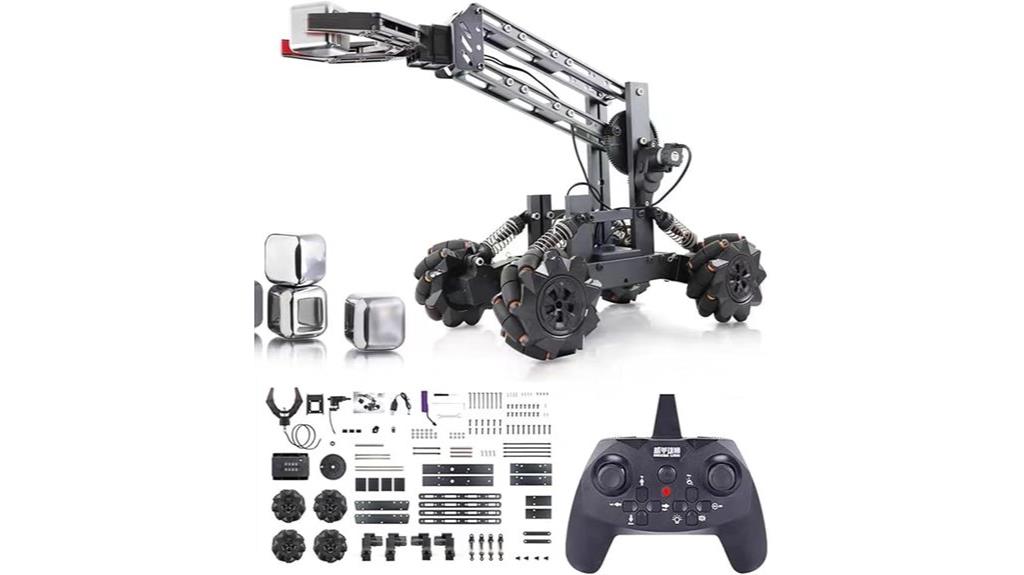
If you’re looking for an engaging STEM activity for kids aged 8 to 12, the VANLINNY Robot Kit offers a hands-on experience that combines robotic cars and arms to boost creativity and engineering skills. It features a programmable robotic arm that moves at different angles, lifts, and grabs objects, along with a smart vehicle and sound effects. The kit includes durable metal and plastic components, a remote control, and DIY tools. While assembly can be tricky due to unclear instructions and some quality issues, many users enjoy the building process and the educational value it provides. Overall, it’s a fun way to introduce kids to robotics and engineering concepts.
Best For: kids aged 8 to 12 who are interested in hands-on STEM learning, robotics, and engineering projects.
Pros:
- Encourages creativity and engineering skills through building and programming.
- Includes durable materials like metal and plastic for safety and reliability.
- Provides educational entertainment with sound effects and functional robotic arms.
Cons:
- Assembly can be complicated due to unclear instructions and missing or defective parts.
- Quality control issues such as poorly drilled metal parts and fragile plastic components.
- Wheels may slip on smooth surfaces, affecting movement and precision.
AESGOGO STEM Robot Kit (12-in-1 Solar Creation Robotics Kit)
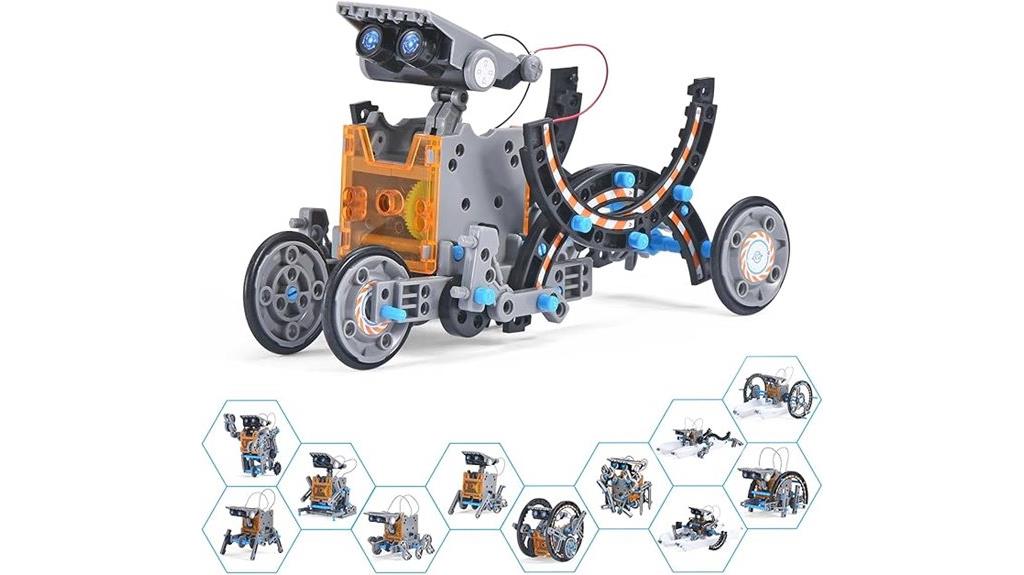
For children aged 8 and up who enjoy hands-on STEM activities, the AESGOGO STEM 12-in-1 Solar Robot Kit offers a versatile and engaging way to explore robotics and renewable energy. This kit lets kids build 12 different robots, including models that move on land and water, catering to various skill levels. Made from durable ABS, it’s suitable for indoor or outdoor play under sunlight or bright indoor lighting. While some assembly can be challenging and the solar panel might need extra help, kids will learn about mechanical parts, energy transfer, and problem-solving. It’s a fun, educational kit that fosters creativity and critical thinking in young engineers.
Best For: children aged 8 and up who are interested in hands-on STEM activities, robotics, and renewable energy exploration.
Pros:
- Encourages creativity, critical thinking, and practical problem-solving skills.
- Made of durable ABS material suitable for indoor and outdoor play.
- Offers educational value by demonstrating mechanical, electrical, and energy transfer concepts.
Cons:
- Assembly can be challenging, especially with small parts and gear mechanisms.
- The solar panel may have limited functionality, sometimes requiring alternative power sources.
- Parts are not pre-labeled or organized, which can increase setup time and difficulty for younger children.
Robot Toys Building Set for Kids and Adults
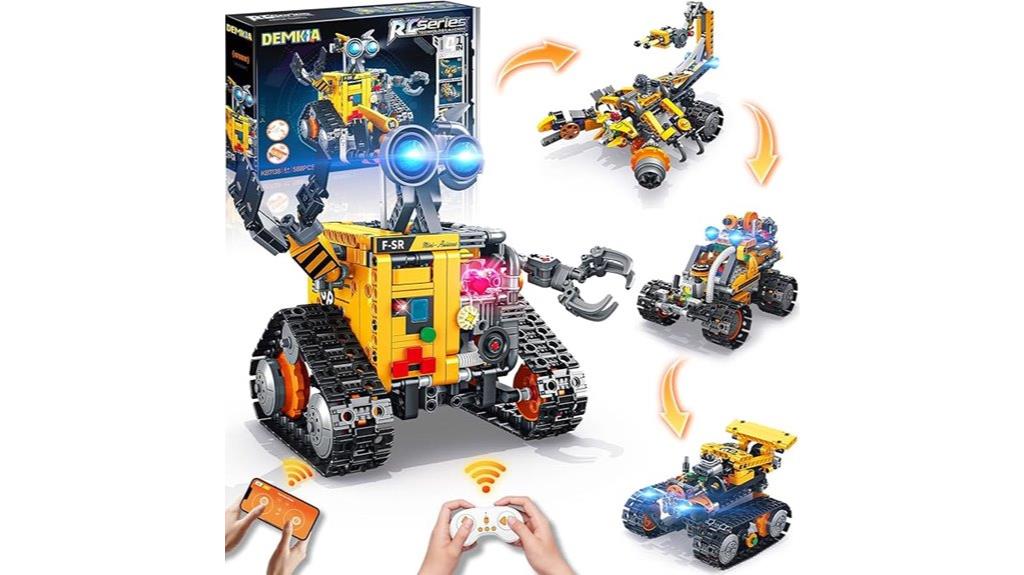
Looking for a hands-on project that sparks creativity and teaches STEM skills? The Demkia 4-in-1 Mech Robot Toys set is perfect. With over 588 pieces, you can assemble a Wall Robot, Scorpion, Crane, Engineering Grader, or Scout Tank. It features fully articulated joints, moving heads, and a chest panel for storage, making each build dynamic and engaging. Designed for ages 6+, it offers challenging instructions that encourage patience and problem-solving. With a rechargeable battery providing 50 minutes of play, plus remote and app controls, this set combines fun with learning. It’s an excellent way for kids and adults to bond while exploring robotics and engineering.
Best For: children aged 6 and above, as well as adults who enjoy hands-on robotics projects and STEM learning.
Pros:
- Offers multiple build options with over 588 pieces, enhancing creativity and problem-solving skills.
- Fully articulated joints and moving parts provide dynamic and engaging play experiences.
- Includes rechargeable battery and remote/app control modes for versatile operation and extended playtime.
Cons:
- Assembly can be complex and time-consuming, requiring adult supervision for younger children.
- Small parts and intricate instructions may pose challenges, especially for beginners.
- Some models may experience parts falling off during play or movement over bumps.
KEYESTUDIO DIY Solar Tracking Electronic Kit for Arduino
The KEYESTUDIO DIY Solar Tracking Electronic Kit for Arduino stands out as an excellent choice for hobbyists, students, and professionals enthusiastic to explore solar energy and sensor integration. It includes essential components like ambient light sensors, servos, a solar panel, and various sensors, all housed in durable metal and acrylic. The kit is unassembled, offering a hands-on experience with step-by-step tutorials that teach sensor control, programming, and solar tracking principles. Compatible with Arduino IDE, it supports customization and expansion through additional modules. With clear instructions and quality parts, it’s perfect for learning electronics, control logic, and renewable energy concepts in a practical, engaging way.
Best For: hobbyists, students, and professionals interested in learning about solar energy, sensor integration, and DIY electronics projects using Arduino.
Pros:
- Comprehensive kit with high-quality components and detailed tutorials for easy assembly and learning.
- Supports customization and expansion with additional sensors and modules through reserved ports.
- Promotes hands-on understanding of solar tracking, programming, and renewable energy concepts.
Cons:
- Requires some programming knowledge for advanced customization and continuous tracking functions.
- Does not include batteries; users need to supply suitable power sources for full operation.
- Minor hardware inconsistencies and occasional missing parts may require troubleshooting or additional purchases.
OSOYOO 2WD Robot Car Starter Kit for Arduino
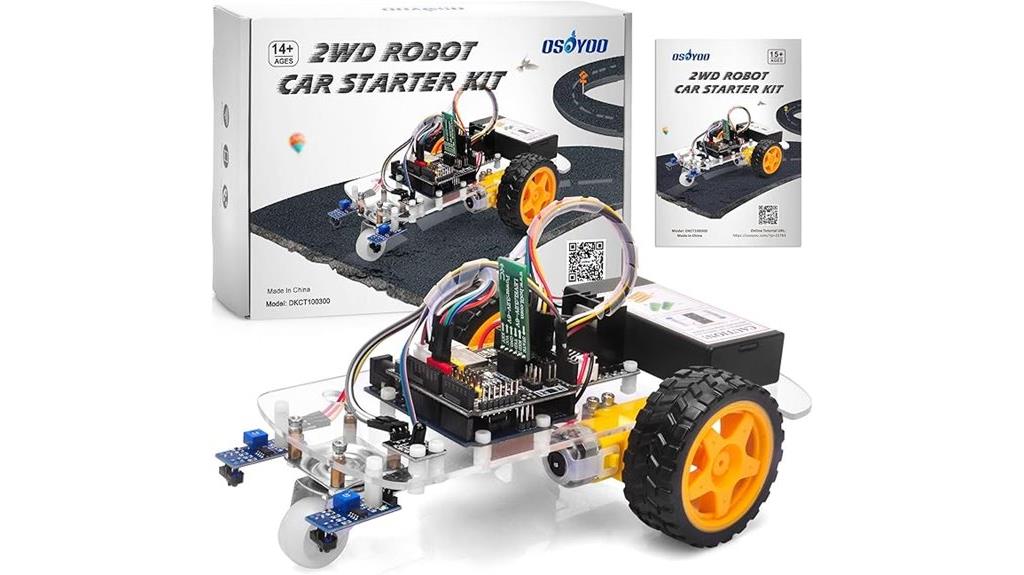
The OSOYOO 2WD Robot Car Starter Kit for Arduino stands out as an ideal choice for STEM beginners and adults keen to explore robotics and programming. It offers a hands-on experience with Arduino, electronics assembly, and robotics concepts through a detailed kit that includes a 2WD chassis, motors, Wi-Fi shield, tracking module, infrared remote, and Bluetooth module. The kit supports multiple control modes like auto-navigation, remote control, line tracking, and wireless control via mobile apps. Designed for easy assembly with online tutorials, it’s perfect for learning basic robotics, though some quality and documentation issues require patience.
Best For: STEM beginners and adults looking for an educational and fun introduction to Arduino-based robotics and programming.
Pros:
- Offers a comprehensive, hands-on learning experience with multiple control modes including wireless options
- Includes step-by-step online tutorials and videos to facilitate easy assembly and programming
- Supports various operation modes like auto-navigation, remote control, and line tracking for versatile experimentation
Cons:
- Quality-control issues such as reversed power switches and inconsistent shield types can cause confusion
- Lacks certain sensors and components like ultrasonic transceivers and limit switches for advanced projects
- Documentation can be inconsistent, and some assembly steps may be challenging for absolute beginners
Mini 3D LED Cube DIY Electronics Kit
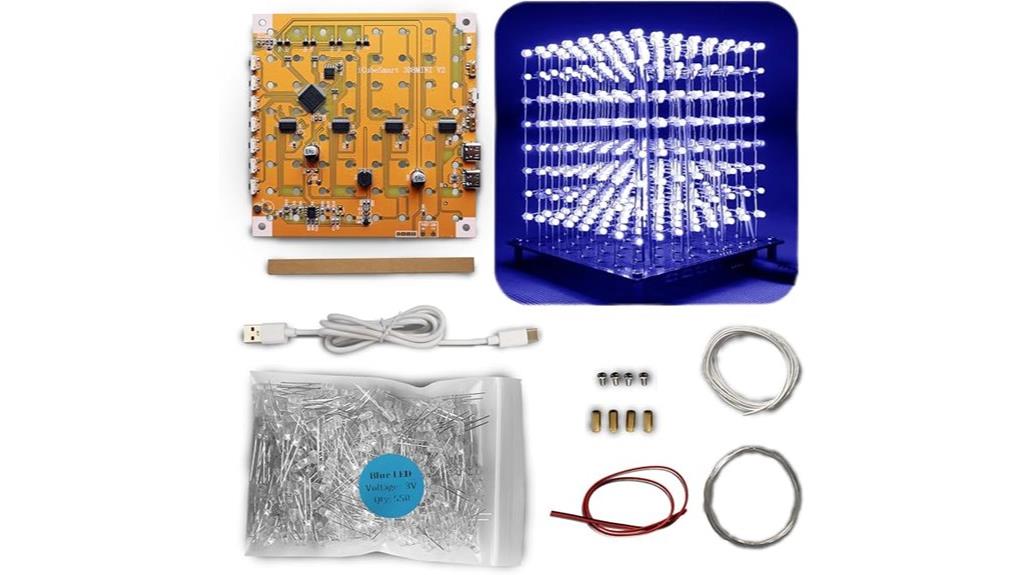
If you’re interested in a challenging yet rewarding electronics project, the Mini 3D LED Cube DIY Electronics Kit is an excellent choice for hobbyists aged 15 and up with soldering experience. It features 512 tiny LEDs in an 8x8x8 cube that can display over 20 animations. The kit includes a circuit board with guide holes, spare LEDs, and four buttons to control effects. While soldering all the LEDs requires patience and precision, the kit offers customization through dedicated software. Keep in mind, software updates may be necessary for full functionality, but the end result is a stunning, programmable 3D light display perfect for tech enthusiasts.
Best For: hobbyists aged 15 and up with soldering experience seeking a challenging and customizable 3D LED display project.
Pros:
- Offers a visually impressive and programmable 3D light display with over 20 animations.
- Includes guide holes and spare LEDs to assist with precise soldering and error correction.
- Allows customization of animations via dedicated software, enhancing creative control.
Cons:
- Requires extensive soldering skills and patience, which may be challenging for beginners.
- Software updates are necessary for full functionality, and outdated software can cause compatibility issues.
- Variability in stencil and board quality can complicate assembly and require additional tools or parts.
MiOYOOW Soldering Practice Kit and Robot Car DIY Kit for Beginners
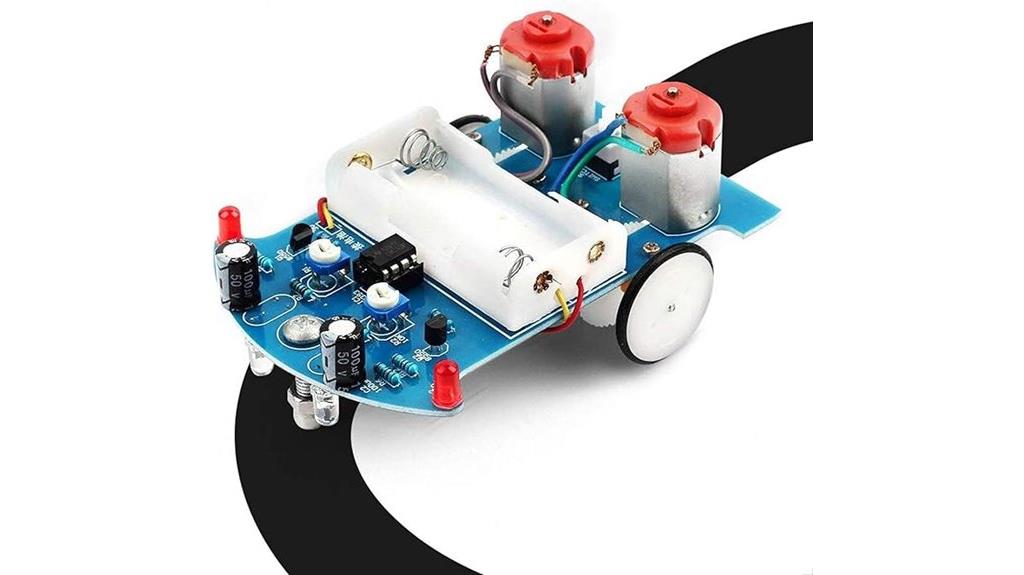
Are you a beginner keen to explore into electronics and robotics? The MiOYOOW Soldering Practice Kit and Robot Car DIY Kit make it easy to start. Designed for ages 10 and up, it teaches soldering, mechanical assembly, and sensor principles through hands-on building. The kit includes resistors, LEDs, photoresistors, motors, and more, with clear instructions and labeled parts. You’ll learn to create a line-following robot that detects surfaces using light sensors and adjusts its direction. Durable and user-friendly, it’s perfect for STEM projects or hobbyist fun. Just follow the steps carefully, and you’ll have your own functioning robot in no time.
Best For: beginners, students, and hobbyists aged 10+ interested in learning soldering, electronics, and robotics through hands-on assembly and experimentation.
Pros:
- Easy-to-follow instructions with clearly labeled components, suitable for beginners
- Durable parts and reliable performance on various tracks for educational and fun use
- Promotes practical skills in soldering, mechanical assembly, and sensor principles
Cons:
- Limited instructions may require referencing additional schematics or online resources
- Some parts, like gear sets and small components, may need careful handling and multiple attempts to align correctly
- Assembly can be time-consuming for complete beginners, especially with delicate soldering steps
Factors to Consider When Choosing DIY Robot Kits
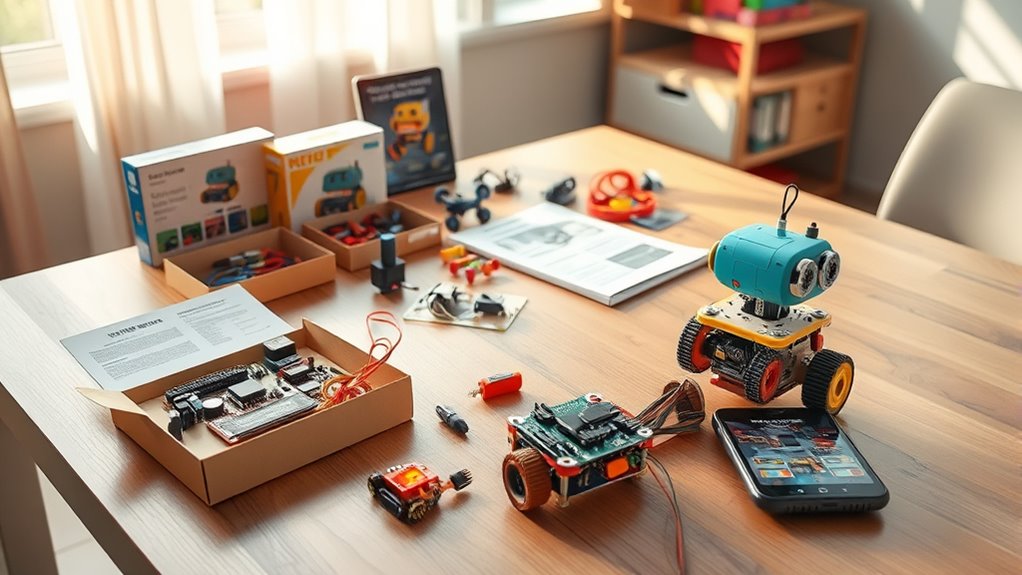
When selecting a DIY robot kit, I always consider who will be building it and their skill level. It’s important to match the complexity and educational value to guarantee the project is both fun and challenging. By thinking about age appropriateness and assembly difficulty, I can choose a kit that provides the right balance of learning and enjoyment.
Age Appropriateness
Choosing the right DIY robot kit starts with matching it to the child’s age. Picking a kit designed for their specific age group guarantees the complexity is appropriate and safety is maintained. For younger kids, look for kits with larger parts, simple instructions, and basic educational content to match their reading and motor skills. For older children, more detailed components and advanced programming challenges are suitable. It’s important to check that the materials and safety features align with their age; for instance, avoiding small parts for younger kids to prevent choking hazards. Ensuring the kit’s content matches their learning goals—whether exploring mechanics or coding—helps keep them engaged and motivated. Proper age-appropriate choices make the building experience both safe and rewarding.
Skill Level Required
Selecting a DIY robot kit that matches your skill level is key to having a rewarding building experience. Kits designed for beginners include clear instructions, pre-wired parts, and simple assembly steps, making them perfect for newcomers with limited technical skills. If you’re more experienced, advanced kits often require soldering, programming, and troubleshooting, which challenge your technical abilities and deepen your understanding. Manufacturers’ age recommendations and difficulty ratings can help you determine if a kit fits your current skills and developmental stage. Choosing a kit that offers a manageable challenge keeps you engaged and helps you build confidence. Progressing gradually from simpler to more complex kits allows you to develop skills steadily, ensuring your robotics journey remains enjoyable and educational.
Building Complexity
Building complexity in DIY robot kits varies widely, from simple snap-together parts to intricate assemblies that require soldering and programming. I’ve found that kits with higher complexity often include advanced electronics, multiple mechanical components, and demand a solid understanding of circuitry and coding. For beginners, pre-assembled modules and clear, step-by-step instructions make assembly easier and less frustrating. On the other hand, more complex kits may involve multiple building stages, customization options, and troubleshooting, which can be challenging but rewarding for those seeking a deeper learning experience. When choosing a kit, I recommend evaluating its building complexity to match your skill level and goals. This guarantees you stay motivated, avoid frustration, and truly enjoy the process of creating your own robot.
Educational Value
When considering the complexity of a DIY robot kit, it’s important to also think about its educational value. A good kit should incorporate core STEM concepts like electronics, mechanics, and programming, helping users learn through hands-on experience. Detailed instructions and tutorials are crucial, as they guide users to understand complex principles effectively. Kits that include diverse, upgradeable components and sensors encourage experimentation, creativity, and deeper understanding of robotics. Additionally, the best educational kits promote problem-solving, critical thinking, and troubleshooting, offering lasting benefits. Finally, a well-designed kit should suit various age groups and skill levels, making robotics accessible while still challenging users to grow their knowledge. This balance ensures meaningful learning and sustained engagement.
Assembly Difficulty
The assembly difficulty of a DIY robot kit depends heavily on how clear the instructions are and the number of small parts involved. Kits with simple, labeled components and step-by-step diagrams make assembly easier, especially for beginners. When instructions are detailed and include visual guides, you’re less likely to get stuck or make mistakes. However, if a kit requires soldering, intricate wiring, or the use of specialized tools like screwdrivers or magnifying glasses, it can considerably increase the challenge. For those with limited experience or dexterity, this can be daunting. Fortunately, many kits now include helpful resources like video tutorials or guided instructions, which can boost confidence and simplify the process, making assembly more manageable and enjoyable.
Material Durability
Choosing a DIY robot kit with durable materials is essential for guaranteeing your project stands the test of time. High-quality materials like ABS plastic, metal alloys, or acrylic are key because they can withstand assembly and repeated use without cracking or breaking. The strength of joints, gears, and connectors directly impacts the robot’s longevity, resisting wear and tear over time. Material resistance to impact, such as shock absorption and toughness, helps the robot endure accidental falls or rough handling. Additionally, using safe, non-toxic materials ensures stability without degrading into debris during assembly or operation. Opting for corrosion-resistant metals and UV-stable plastics maintains the robot’s appearance and structural integrity, allowing it to stay functional and looking good for years to come.
Power Source Needs
Selecting the right power source for your DIY robot kit is essential because it directly affects performance, safety, and ease of use. Depending on your project, you might choose batteries like AA, lithium-ion packs, or rechargeable options, each offering different convenience and longevity. Some kits require specific voltages or battery types, so double-check compatibility to avoid malfunctions or safety issues. Solar panels can be a great eco-friendly option, promoting renewable energy learning, but they depend on sunlight or indoor lighting for ideal operation. Rechargeable batteries add convenience, often with USB charging, and are more sustainable. Also, consider whether the power source is user-replaceable or integrated; this impacts maintenance, upgrades, and how long your robot can operate without intervention.
Software Compatibility
Have you ever wondered if the software in a DIY robot kit will work smoothly with your device? It’s essential to check compatibility with your operating system—whether you’re on Windows, macOS, Android, or iOS—to avoid surprises. Next, consider the programming environment supported by the kit, like Arduino IDE, Scratch, or Python, and ensure it matches your skill level and learning goals. Some kits come with pre-installed firmware, while others require manual software setup; knowing this helps plan your setup process. Also, verify that the software supports key features such as remote control, sensor integration, or AI capabilities relevant to your projects. Finally, look for accessible support resources like updates, user forums, and troubleshooting guides to keep your creative flow uninterrupted.
Frequently Asked Questions
What Safety Precautions Should I Follow When Building DIY Robot Kits?
When building DIY robot kits, safety should always come first. I make sure to read all instructions carefully and wear safety goggles to protect my eyes from small parts or debris. I also work in a well-ventilated area and keep away from electrical components while working on wiring. Remember to unplug devices before handling sensitive parts and keep your workspace organized to avoid accidents.
Are DIY Robot Kits Suitable for Absolute Beginners or Only Experienced Builders?
Thinking about DIY robot kits is like opening a box of chocolates—there’s a little of everything! I believe many kits are perfect for absolute beginners, offering step-by-step instructions and user-friendly parts. They’re designed to be approachable, like a friendly guide helping you learn. So, whether you’re just starting out or have some experience, there’s usually a kit that fits your skill level and sparks your creativity.
How Much Time Does It Typically Take to Complete a DIY Robot Kit?
The time it takes to complete a DIY robot kit varies depending on the complexity and your experience. For beginners, it usually takes a few hours to a weekend, as you’ll need time to understand instructions and assemble parts. More advanced kits might take several days or even weeks, especially if you’re customizing or troubleshooting. I recommend setting aside dedicated, uninterrupted time to enjoy the process and learn along the way.
Can DIY Robot Kits Be Customized or Upgraded After Initial Assembly?
Thinking of DIY robot kits as Lego sets, I’ve found they’re often designed for upgrades and customization. I once added sensors and new arms to my first robot, transforming its capabilities. Most kits today support modular parts, so you can upgrade or personalize after assembly. It’s like customizing a car—swap out parts, add features, and make your robot uniquely yours. So yes, you can definitely upgrade or customize your DIY robot kit!
What Are the Best Resources for Troubleshooting Common DIY Robot Kit Issues?
When troubleshooting common DIY robot kit issues, I rely on online forums and dedicated tutorial videos. I find communities like Reddit’s r/robotics or specific kit manufacturer support pages really helpful. Sometimes, I consult user manuals or reach out to customer service. These resources help me identify problems quickly, whether it’s wiring, programming, or hardware glitches, ensuring I can get my robot up and running smoothly again.
Conclusion
So, whether you’re a budding inventor or just looking to channel your inner Da Vinci, these DIY robot kits are perfect for sparking creativity. Remember, even in the age of smartphones and AI, building something with your own hands feels just as magical as discovering a hidden treasure chest in an old adventure game. Jump in, experiment, and have fun—after all, the best way to learn is through hands-on adventure!
